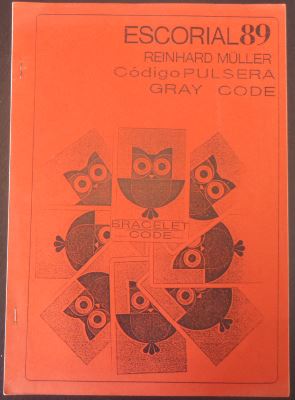©1989 Reinghard Müller
Softcover, stapled-manuscript, 8.5x11", 26 pages

Image courtesy eBay seller LeoCuellar
| Müller, Reinhard: Escorial 89 Gray
Code, Codigo Pulsera ©1989 Reinghard Müller Softcover, stapled-manuscript, 8.5x11", 26 pages |
 Image courtesy eBay seller LeoCuellar |
Comments:
Contents
1 1. Introduction
3 2. Bringing In Effects
3 2.1 Card Divination I
5 2.2 Card Divination II
7 2.3 Core Memory Four Card Variant
9 3 Basic Principle
9 3.1 The 8-Bit-Binary-Code
9 3.1.1 How to Gray Code a Set of Cards?
10 3.1.2 Why Have We to Use a Block of Three Cards?
10 3.1.3 How to Get the Value of a Card?
11 3.1.4 How to Get the Suit of a Card?
11 3.2 Hints of Further Developments
11 3.2.1 Two Identification Marks (i-marks)
12 3.2.2 Four I-Marks
13 4 Selected Tricks
13 4.1 Impromptu Effects
13 4.2 Prepared Effects
16 4.3 Set-Up Cards as Resources
17 5 Technical Notes
17 5.1 Kinds of Gray Code Stacks
17 5.1.1 The Whole Deck is Stacked
17 5.1.2 A Part of the Deck is Stacked
18 5.1.3 Manifold Stacked Decks
18 5.2 Basic Principles for Getting the Information
18 5.2.1 Visual Information
18 5.2.1(a) The Performer is Active for Informing Himself
19 5.2.1(b) The Performer is Active to Inform His Medium
19 5.2.1(c) The Spectator Unconsciously Helps the Performer
20 5.2.2 Automatic Information
20 5.2.3 Touch Information
21 5.3 Aftermaths of the Code
21 5.3.1 Calculation
21 5.3.2 Shuffle
21 5.3.3 Elimination
22 5.4 Combinations With the Gray Code
22 5.4.1 Si Stebbins System
22 5.4.2 Estimation
22 5.4.3 Stay-Stack
23 5.4.4 Faro-Shuffle
23 5.5 Invariabilities
23 5.5.1 Shuffle
24 5.5.2 Cut
24 5.5.3 Sorting
24 5.5.4 Special Codes
25 5.6 Weakness of the Gray Code
26 6 Specifications of Used Sources
